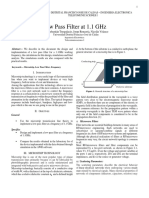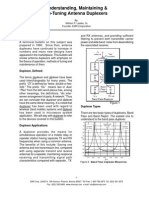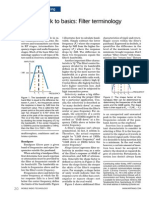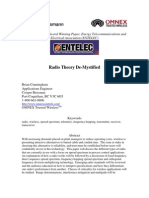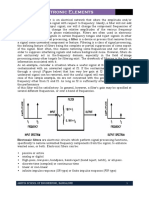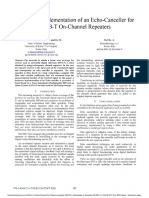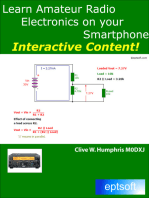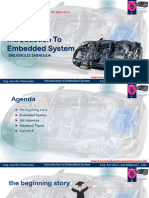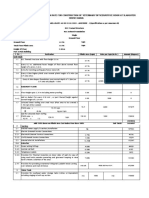InsertionLoss in BandPassCavities
InsertionLoss in BandPassCavities
Uploaded by
Thảo Phạm QuangCopyright:
Available Formats
InsertionLoss in BandPassCavities
InsertionLoss in BandPassCavities
Uploaded by
Thảo Phạm QuangOriginal Title
Copyright
Available Formats
Share this document
Did you find this document useful?
Is this content inappropriate?
Copyright:
Available Formats
InsertionLoss in BandPassCavities
InsertionLoss in BandPassCavities
Uploaded by
Thảo Phạm QuangCopyright:
Available Formats
Insertion Loss in Band Pass Cavity Filters
By Jim Reville
Bird Technologies Group Engineer
In Land Mobile Radio (LMR) desense. You must also supply filtering on your
receivers to prevent a transmitter from overloading or
transmitting and receiving desensitizing a receiver. Transmitter noise
applications, cavity filtering is used suppression (TN) is the amount of isolation required
in two ways. on the transmitter to protect the receiver from
sideband noise. Receiver desense carrier
First, a cavity filter must be able to pass the desired suppression (RD) is the amount of isolation required
signal with a minimum of loss. Second, the filter must to protect the receiver from a high level transmitter
reduce, or eliminate undesirable signals with carrier.
maximum efficiency. An ideal (perfect) filter of the
highest quality would allow us to pass a desirable Bandpass cavity filters are used to pass a desired
signal through it without any loss. It would also be signal at the filters tuned frequency. The desired
capable of completely removing all undesirable frequency is at the center of the curve in figure 2.
portions of the signal. But, we do not live in a perfect
world and we must abide by the laws of physics
Figure 2 – Band pass cavity curves
Insertion loss has the following affect on the filtering
provided: the higher the insertion loss setting, the
narrower the bandwidth of the desired signal passed
Figure 1 – Top view of a typical band pass cavity filter through the filter. A lower insertion loss setting results
in a wider bandwidth. Bandwidth may also be
In our imperfect world, radio transmitters generate modified by adding additional bandpass cavities in
both a desirable signal as well as undesirable signals. series. Additionally, the bandwidth may be affected
The undesirable signals we will discuss here are by the length of the cable used between the cavities if
called wide band transmit noise. Many modern more than one is used in a particular application.
transmitters often generate more of this type of noise Insertion loss is not the only factor that affects
than traditional transmitters. Cavity filters are used to bandwidth of the signal passed through the filter.
in both transmitter and receiver systems.
In a cavity filter, the amount of insertion loss
There are two considerations in providing filtering in determines, in part, how much filtering you get out of
LMR type transmitter and receiver systems. When the cavity. In the figure 2 the insertion loss settings
using a duplexer or TX/RX combiner filtering system, have been varied from a loss of 0.5dB up to 3.0 dB to
you must filter the wide band transmitter noise out of show the resulting filtering characteristics. The higher
the transmitted signals to protect your site receivers. the insertion loss setting is, the sharper or narrower
TN/RD is short for transmitter noise and receiver the band of pass frequencies. The curve at the top of
figure 1 shows the lowest insertion loss setting. The
bottom curve illustrates the response of the filter at
1 | Bird Technologies Group
866.695.4569
www.bird-technologies.com
Insertion Loss in Band Pass Cavity Filters
By Jim Reville
Bird Technologies Group Engineer
the highest insertion loss setting. The lower the The highest insertion loss is achieved when the loops
insertion loss setting, the less filtering is supplied, are rotated 90 degrees so that the narrowest side of
which produces a wider pass band. The higher the the loop is facing the stationary probe. This is the
insertion loss setting, the narrower the frequency pass position where the RF signal is minimally coupled
band is, covering a narrower spectrum. It then through the cavity.
provides more attenuation above and below the pass
frequency.
In this type of cavity filter the insertion loss is adjusted
by rotating the loops. A photograph of the loop
appears in figure 4 below.
Figure 4 – One of two loops used in a UHF band pass
cavity
Figure 6 – band pass cavity theory
The loops are both rotated relative to the stationary
probe. See figure 5 below for the stationary probe. There are several factors which contribute to energy
The lowest insertion loss is achieved when the loops losses that occur in a cavity filter. There is no free
are rotated such that the widest part of the loop is lunch when it comes to physics. An increase in
facing toward the stationary probe. In this position the filtering requires a corresponding increase in insertion
RF signal is fully coupled through the cavity. To loss.
achieve maximum coupling, the tuning probe must be
adjusted to a length equal to ¼ wavelength of pass In a transmitter application, physics dictates that an
frequency. This is accomplished by moving the increase in the insertion loss setting of a cavity will
movable probe which is shown in figure 5 below. The cause a corresponding increase of power dissipation
physics involved here is illustrated in figure 6 below. in the form of heat. The cavity must be able to
dissipate the heat generated without affecting the
filters characteristics such as resonant frequency
(pass frequency) that the cavity is tuned to. A
temperature compensated cavity provides
temperature stability.
Radiated Energy can be lost through poorly shielded
interconnect cables. Bird Technologies suggests the
use of double shielded cable in all of our systems to
minimize this type of loss.
There are other types of cavities that have different
characteristics. These may be the topic of future
Figure 5 – Cutaway showing band pass cavity internal papers.
construction
2 | Bird Technologies Group
866.695.4569
www.bird-technologies.com
You might also like
- Workz Korn Ferry MappingDocument1 pageWorkz Korn Ferry Mappingfungcheu7193No ratings yet
- Affidavit of EmploymentDocument2 pagesAffidavit of EmploymentReshiel B. CCNo ratings yet
- Insertion Loss in Bandpass CavitiesDocument3 pagesInsertion Loss in Bandpass CavitiesDuy ĐặngNo ratings yet
- Band-Pass FilterDocument5 pagesBand-Pass Filterkeisha555No ratings yet
- Phase Locked Oscillator 2Document2 pagesPhase Locked Oscillator 2Al BaniNo ratings yet
- T6 System Design: Chapter - 8Document8 pagesT6 System Design: Chapter - 8lvsaruNo ratings yet
- Decibel FilterDocument2 pagesDecibel Filterbinhmaixuan100% (1)
- Low Pass Filter at 1.1 GHZ: Daniel Sebastián Trespalacio, Jorge Roncería, Nicolás VelascoDocument5 pagesLow Pass Filter at 1.1 GHZ: Daniel Sebastián Trespalacio, Jorge Roncería, Nicolás VelascoDaniel TrespalacioNo ratings yet
- Design of Duplexer For 5g Mimo AntennaDocument4 pagesDesign of Duplexer For 5g Mimo AntennaInternational Journal of Innovative Science and Research TechnologyNo ratings yet
- Optical Cavities As Amplitude Filters For Squeezed FieldsDocument9 pagesOptical Cavities As Amplitude Filters For Squeezed FieldsSasa TopicNo ratings yet
- Duplexer ManualDocument12 pagesDuplexer Manualflegias100% (1)
- Filtry Od MFC: Product Report Vysokofrekvenční FiltryDocument4 pagesFiltry Od MFC: Product Report Vysokofrekvenční FiltryAlexander WieseNo ratings yet
- Getting Back To Basics: Filter Terminology: Technically SpeakingDocument2 pagesGetting Back To Basics: Filter Terminology: Technically SpeakingSlardarRadralsNo ratings yet
- Below Frequency Response of A 2nd Order Band Pass FilterDocument11 pagesBelow Frequency Response of A 2nd Order Band Pass FilterNurul FathiaNo ratings yet
- Wideband Pass Filter With OP Amplifier: (F) Rsub (C)Document3 pagesWideband Pass Filter With OP Amplifier: (F) Rsub (C)Benj MendozaNo ratings yet
- Design of Microstrip Bandpass Filter For 20% Fractional Bandwidth Around 3 GHZDocument10 pagesDesign of Microstrip Bandpass Filter For 20% Fractional Bandwidth Around 3 GHZFa Mido ChemseddineNo ratings yet
- Lab No 13: Course: Electrical Engineering Lab Course Code: EE-209 LDocument5 pagesLab No 13: Course: Electrical Engineering Lab Course Code: EE-209 Lmuhammad faheem ziaNo ratings yet
- Filtres Fabriqués Par MFC: Product Report Filtres À Haute FréquenceDocument4 pagesFiltres Fabriqués Par MFC: Product Report Filtres À Haute FréquencetelesatellitefrenchNo ratings yet
- تاقيبطتلا عاونا عيمجل Hf رتلاف C قاطنلا رتلف قوس يف ريبك لكشب ةحجان ىرخأ نيب نمWimax تاهجاو تلاخادت عنمل ريبك لكشب ةصصخم رتلاف ددرتلا لصف رتلاف ليدبتل اهجمد نكمي رورملا ةضفخنم و رورملا ةيلاع رتلافDocument4 pagesتاقيبطتلا عاونا عيمجل Hf رتلاف C قاطنلا رتلف قوس يف ريبك لكشب ةحجان ىرخأ نيب نمWimax تاهجاو تلاخادت عنمل ريبك لكشب ةصصخم رتلاف ددرتلا لصف رتلاف ليدبتل اهجمد نكمي رورملا ةضفخنم و رورملا ةيلاع رتلافAlexander WieseNo ratings yet
- Wideband Pass Filter With OP Amplifier: I (Section 1)Document2 pagesWideband Pass Filter With OP Amplifier: I (Section 1)Benj MendozaNo ratings yet
- Filter Buatan MFC: Product Report Filter Frekuensi-TinggiDocument4 pagesFilter Buatan MFC: Product Report Filter Frekuensi-TinggiAlexander WieseNo ratings yet
- Cs307 System Software KTUDocument7 pagesCs307 System Software KTUDeepak K VNo ratings yet
- Receiver SensitivityDocument16 pagesReceiver Sensitivityse7en_csNo ratings yet
- Frecuency DriversDocument14 pagesFrecuency DriversfelipeNo ratings yet
- Filtri Prodotti Da MFC: Product Report Filtri Ad Alta FrequenzaDocument4 pagesFiltri Prodotti Da MFC: Product Report Filtri Ad Alta FrequenzaAlexander WieseNo ratings yet
- Receiver SensitivityDocument16 pagesReceiver Sensitivityse7en_csNo ratings yet
- LECTURE 4 - AM ReceptionDocument48 pagesLECTURE 4 - AM ReceptionDonald Billy C. Abugan IINo ratings yet
- Rajiv Gandhi Memorial: Telecom Training CentreDocument28 pagesRajiv Gandhi Memorial: Telecom Training CentreMuthukrishnan ThiagarajanNo ratings yet
- Wideband Pass Filter With OP Amplifier: (F) Rsub (C)Document3 pagesWideband Pass Filter With OP Amplifier: (F) Rsub (C)Benj MendozaNo ratings yet
- S C S C: Ignal Onditioning and Ignal OnditionersDocument22 pagesS C S C: Ignal Onditioning and Ignal OnditionersWan LynnNo ratings yet
- Aliasing Filter DesignDocument4 pagesAliasing Filter Designarun vaddeNo ratings yet
- Radio Theroy DemystifyDocument15 pagesRadio Theroy DemystifyrvslifeNo ratings yet
- Wireless System Design Top-Level Issues: Technical Brief AN119Document19 pagesWireless System Design Top-Level Issues: Technical Brief AN119David Chandy PesantezNo ratings yet
- Dispersive Delay Lines: Matched Filters For Signal ProcessingDocument7 pagesDispersive Delay Lines: Matched Filters For Signal ProcessingMini KnowledgeNo ratings yet
- K Band Pass FilterDocument10 pagesK Band Pass Filterharshraj_88No ratings yet
- Filtros Wifi-Rojas Rojas IvanDocument3 pagesFiltros Wifi-Rojas Rojas IvanLuis Eduardo RojasNo ratings yet
- ACtive Notch Filter DesignDocument43 pagesACtive Notch Filter DesignDrMohammad Rafee ShaikNo ratings yet
- Aurora Networks, IncDocument10 pagesAurora Networks, IncJuan ZapataNo ratings yet
- اسئلة واجوبة الاتصالاتDocument8 pagesاسئلة واجوبة الاتصالاتrootbird08No ratings yet
- Elp 311Document9 pagesElp 311Srijan SinghNo ratings yet
- Direct Conversion Radio Transceivers For Digital CommunicationsDocument12 pagesDirect Conversion Radio Transceivers For Digital CommunicationsA. Villa100% (2)
- Filters NotesDocument20 pagesFilters NotesKart HikNo ratings yet
- 1-Bandwidth Enhancement in Band Pass Filter BPF Using Microstrip Couple Lines For WLAN 2.4GHZ ApplicationsDocument4 pages1-Bandwidth Enhancement in Band Pass Filter BPF Using Microstrip Couple Lines For WLAN 2.4GHZ ApplicationsJohn JohnNo ratings yet
- 3001 Coms SummaryDocument29 pages3001 Coms SummaryJeremiash ForondaNo ratings yet
- Implementation Repeaters: Hardware of An Echo-Canceller For On-ChannelDocument3 pagesImplementation Repeaters: Hardware of An Echo-Canceller For On-ChannelDinha AbreuNo ratings yet
- Pulse ShapingDocument3 pagesPulse ShapingElaph AlabasyNo ratings yet
- Intermediate Frequency FilterDocument9 pagesIntermediate Frequency FilterVasu Gupta100% (1)
- SAMPLE PaperDocument5 pagesSAMPLE PaperDeepika KumariNo ratings yet
- Frequency Re-use Concept,Fading, Diversity, C-I, C-ADocument36 pagesFrequency Re-use Concept,Fading, Diversity, C-I, C-As.ravikantsharmaNo ratings yet
- Anti AliasDocument17 pagesAnti Aliasdds70No ratings yet
- Filtri Tvrtke MFC: Product Report Visokofrekvencijski FiltriDocument4 pagesFiltri Tvrtke MFC: Product Report Visokofrekvencijski FiltriAlexander WieseNo ratings yet
- The Receiver Front End: An OverviewDocument7 pagesThe Receiver Front End: An OverviewDragan IvanovNo ratings yet
- New Microsoft Office Word DocumentDocument9 pagesNew Microsoft Office Word DocumentGomalavalli RNo ratings yet
- Digital Communication UNIT 2Document17 pagesDigital Communication UNIT 2Nihal GuptaNo ratings yet
- Dr.M.sushanth Babu - Cellular and Mobile CommunicationsDocument133 pagesDr.M.sushanth Babu - Cellular and Mobile CommunicationsSushanth Babu100% (1)
- Analog Commuunications-Unit-4Document12 pagesAnalog Commuunications-Unit-4v c sekhar gollaNo ratings yet
- Paper NewDocument8 pagesPaper NewDrubo NilNo ratings yet
- 2.1.1.pptxDocument25 pages2.1.1.pptxPriyanshoo KumarNo ratings yet
- Unit II Radio ReceiversDocument29 pagesUnit II Radio ReceiversecekluNo ratings yet
- Thakur Institute of Aviation Technology: 3.16 Filters CAR 66 Reference Level B2 FiltersDocument4 pagesThakur Institute of Aviation Technology: 3.16 Filters CAR 66 Reference Level B2 FiltersKULDEEP patilNo ratings yet
- Amateur Radio Electronics on Your MobileFrom EverandAmateur Radio Electronics on Your MobileRating: 5 out of 5 stars5/5 (1)
- Synthesis of General Topology Multiple Coupled Resonator FiltersDocument4 pagesSynthesis of General Topology Multiple Coupled Resonator FiltersThảo Phạm QuangNo ratings yet
- MOTL2014Document6 pagesMOTL2014Thảo Phạm QuangNo ratings yet
- Design Method For Butter Cheby Bandpass FiltersDocument11 pagesDesign Method For Butter Cheby Bandpass FiltersThảo Phạm QuangNo ratings yet
- Coaxial Low-Pass Filter Design and ManufactureDocument10 pagesCoaxial Low-Pass Filter Design and ManufactureThảo Phạm QuangNo ratings yet
- MWCL2004 MatrixDocument4 pagesMWCL2004 MatrixThảo Phạm QuangNo ratings yet
- Tuning Ports in The Middle of ResonatorsDocument3 pagesTuning Ports in The Middle of ResonatorsThảo Phạm QuangNo ratings yet
- Crytel Business Plan 1Document38 pagesCrytel Business Plan 1Yosef WorkuNo ratings yet
- Class Activity Pub560Document11 pagesClass Activity Pub560SuhaNo ratings yet
- Operation Management: On The Completion of The Course, The Students CanDocument2 pagesOperation Management: On The Completion of The Course, The Students CanEdemson NavalesNo ratings yet
- The Following Format Should Be FollowedDocument2 pagesThe Following Format Should Be FollowedattiqueNo ratings yet
- Financial Management - SmuDocument0 pagesFinancial Management - SmusirajrNo ratings yet
- Leiðarvísir - The Itinerary of Abbot NikulásDocument4 pagesLeiðarvísir - The Itinerary of Abbot NikuláshamishieriNo ratings yet
- Practitioner: Positive Change in Health CareDocument2 pagesPractitioner: Positive Change in Health CareDivyaDeepthi18No ratings yet
- Thunderbird Analysis - Web DataDocument915 pagesThunderbird Analysis - Web DataArjun GoleNo ratings yet
- Introduction To Embedded SystemV4Document89 pagesIntroduction To Embedded SystemV4amr083021No ratings yet
- 4.veterinary Office PDFDocument2 pages4.veterinary Office PDFEr Mansoor HussainNo ratings yet
- 9922Document81 pages9922dewanekrenNo ratings yet
- Rab HPS - R2 - 2023 - PolresDocument147 pagesRab HPS - R2 - 2023 - PolresIla MaNo ratings yet
- NetionicDocument5 pagesNetionicmehekoy154No ratings yet
- PreviewpdfDocument79 pagesPreviewpdfcrisuanNo ratings yet
- Participatory Operation and Maintenance of Irrigation Schemes: Training Manual 10Document61 pagesParticipatory Operation and Maintenance of Irrigation Schemes: Training Manual 10Joseph Rana SangpangNo ratings yet
- Bevi Brochure FEB2019 CompressedDocument12 pagesBevi Brochure FEB2019 Compressedmarinanagy211No ratings yet
- Informasi Rekening - Mutasi Rekening: TGL Keterangan Cabang Jumlah SaldoDocument2 pagesInformasi Rekening - Mutasi Rekening: TGL Keterangan Cabang Jumlah Saldonurul annisaNo ratings yet
- ISO-14897-2002Document9 pagesISO-14897-2002hralrabeea60No ratings yet
- Cbse Sample Papers For Class 9 Social Science With Answers 2014 Paper 1Document11 pagesCbse Sample Papers For Class 9 Social Science With Answers 2014 Paper 1RAGHAVNo ratings yet
- ECU Access and Code Action RequiredDocument4 pagesECU Access and Code Action RequiredPetrovics Attila100% (1)
- Ce6403 SveDocument160 pagesCe6403 SvenewscribduserNo ratings yet
- En Tanagra Calcul P ValueDocument21 pagesEn Tanagra Calcul P ValueBooks pujariNo ratings yet
- Assignment 2 LettersDocument3 pagesAssignment 2 Lettersapi-459182310No ratings yet
- TaskRabbitDocument7 pagesTaskRabbitKim Hằng KimNo ratings yet
- Synchro ProDocument115 pagesSynchro Probati2011dz4521100% (1)
- shs12 PDFDocument5 pagesshs12 PDFMelrose ValencianoNo ratings yet
- LVR GR 10 12 Course Selection Guide 2018 19Document60 pagesLVR GR 10 12 Course Selection Guide 2018 19api-105885756No ratings yet
- Ebay Inc Strategic ManagementDocument142 pagesEbay Inc Strategic Managementnikhilsharma567% (9)







